
1/72 Bloch M.B. 80/81
| KIT #: | |
| PRICE: | $ |
| DECALS: | Home made |
| REVIEWER: | Chris Peachment |
| NOTES: |
Made from 10 and 5 thou plastic card. |

| HISTORY |
The
MB.81
was Marcel Bloch's first aircraft to take to the air, his previous ones having
been prototypes. It was designed as a flying
ambulance and built to carry one passenger on a stretcher in a compartment
between the engine and the cockpit. It was developed according to a new doctrine
of aerial first aid, and was employed only in the French colonies of Morocco and
Syria.
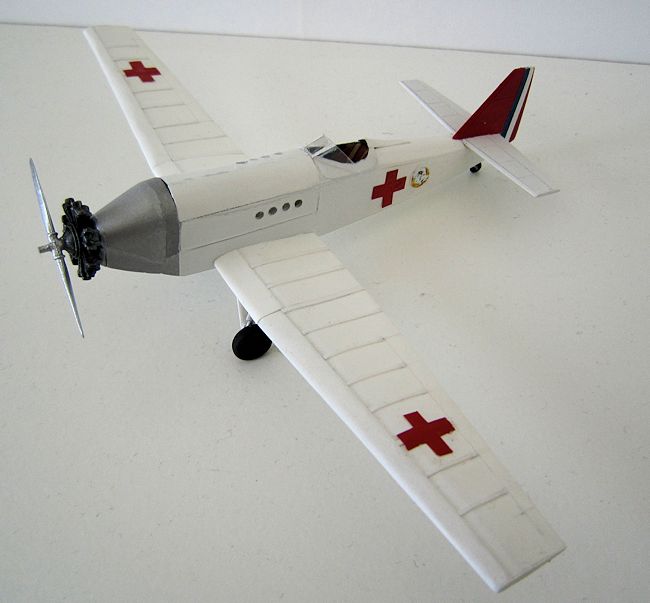 The aircraft sought out patients and casualties by scouting, even at
high altitudes, during military operations in mountainous country, especially
over the Atlas mountains in Morocco.
The aircraft sought out patients and casualties by scouting, even at
high altitudes, during military operations in mountainous country, especially
over the Atlas mountains in Morocco.
Its obvious main feature was the long compartment in the forward
fuselage to accommodate a stretcher, though later the wings were also modified
to carry
casualties, who could speak to the pilot by an Aviaphone system.
The M.B.80 made its first flight in the summer of 1932, with a Lorraine
engine of 120hp which gave it a speed of 190 km/h at 21,000 ft. It could take
off in 230 ft and land in 312 ft. During testing, it carried out 209 landings in
one and a half days without any problem. An initial order for 20 was placed by
the Ground French Forces.
The production model, the M.B.81, was fitted with a French Salmson
engine of 175hp, and took part in military operations in Morocco and Syria in
the early 30s.
A few were used in 1939-1940, before the French surrender, and also in
July, 1941 in the battle for Syria between the Vichy French forces and the Free
French together with the British.
| CONSTRUCTION |
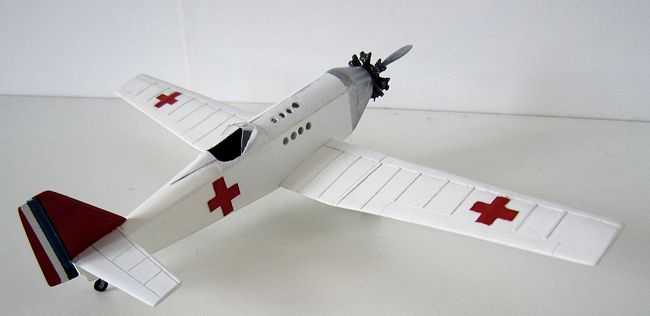
The
fuselage floor was cut first from 20 thou plastic sheet and the nose area bent
upwards. The sides were then cut out for the same material, but leaving the
stretcher compartment doors off at this stage. The cockpit was fenced off,
detailed with seat and stick and panel, all from the spares box, and the top
fuselage cockpit coaming cut our according to the card model plans. These were
wrapped around the metal handle of an old craft knife, and plunged into hot
water to hold their shape, before glueing.
The
engine bearing area offers a tricky job because of its several panels curving in
different planes. Again the card model plans proved invaluable and it was cut
from 10 thou card and carefully glued down.
I had decided to make a scale stretcher,
with a patient resting on it under a blanket. And so the
thin card panels that cover that area are in fact held down with internal strips
of marking tape, which is why they
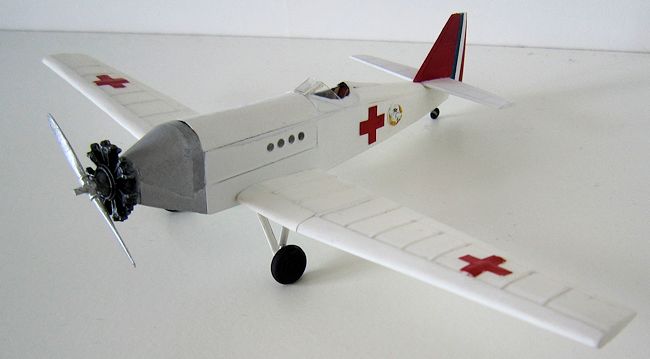 don't quite marry. The rows of little
portholes, presumably designed to prevent the patient going mad with
claustrophobia, were marked with a plastic draughtsman's sheet of circles
and gingerly cut out using a sharp scalpel. They can be
filled later, after painting, with
Humbrol's Clearview.
Any wood glue which dries clear would work as well.
don't quite marry. The rows of little
portholes, presumably designed to prevent the patient going mad with
claustrophobia, were marked with a plastic draughtsman's sheet of circles
and gingerly cut out using a sharp scalpel. They can be
filled later, after painting, with
Humbrol's Clearview.
Any wood glue which dries clear would work as well.
The wings were constructed from the usual method of marking out the
bottom wing, fitting an internal spar 1/3 of the way back from the leading edge,
then adding the top wing, and glueing leading and trailing edges.
One very noticeable feature on the Bloch 81 is the extra
skinning on the leading edge and the pronounce wing ribs. These were all cut
from 10 thou card and glued down.
The
tail planes were made from solid card, sanded down to aerofoil shape, and the
horizontal areas skinned like the wings.
The windscreen came from an old piece of plastic packaging, of which I
have a huge pile under the wardrobe, much to my cat's delight. It was masked to
represent the frame and painted white.
The forward leaning undercarriage legs were
made from plastic strut. Wheels came from the Big Bag of Dead Wheels, likewise
the tail wheel.
And the engine and prop also came from the spares box.
| COLORS & MARKINGS |
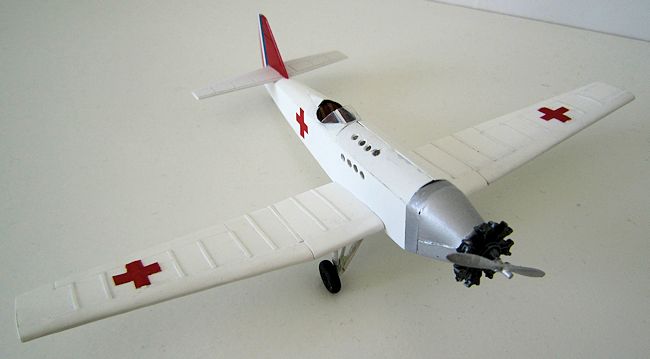 Before
fitting all the last details the whole thing was blasted with Humbrol Primer
White, which is an excellent paint, self-levelling and drying to a uniform matt.
The nose area was masked off and painted with Humbrol 11 from a rattle can. The
fin was red, with tricolour markings on the rudder.
Before
fitting all the last details the whole thing was blasted with Humbrol Primer
White, which is an excellent paint, self-levelling and drying to a uniform matt.
The nose area was masked off and painted with Humbrol 11 from a rattle can. The
fin was red, with tricolour markings on the rudder.
The Red Cross markings were cut from decal sheet which had been sprayed red. The motif on the port side of the cockpit was copied from the useful website Wings Palette. It is too small to be seen in the pictures but it depicts a nurse, who is wearing rather more over her face than the usual face mask, and so would be Arab. It wouldn't be there nowadays since France has banned the wearing of the burka. The UK recently wondered whether to follow suit, but decided against.
| CONCLUSIONS |
I wanted to model this excellent aircraft because it was Marcel Bloch's
first, and he is sadly under-represented by mainstream model makers. Bloch was a
remarkable man. Because he was Jewish, he was forbidden to build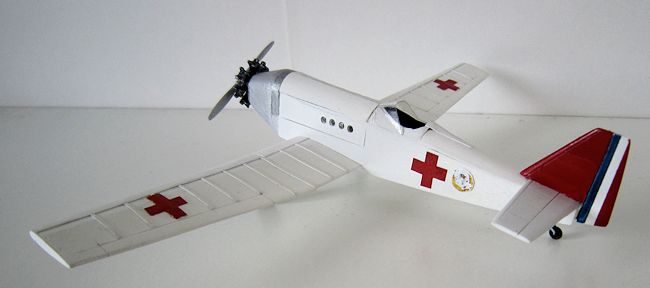 aircraft under
the German occupation, and was then deported to Buchenwald which he survived. He
changed his name from Bloch to Dassault, which was the Resistance codename of
his brother, who was an Army General.
The name Dassault derived from Char D'Assault, or Battle
Tank, and is with us still in the forefront of France's post war aviation.
aircraft under
the German occupation, and was then deported to Buchenwald which he survived. He
changed his name from Bloch to Dassault, which was the Resistance codename of
his brother, who was an Army General.
The name Dassault derived from Char D'Assault, or Battle
Tank, and is with us still in the forefront of France's post war aviation.
I have
yet to make a satisfactory figure on a stretcher for it, and given my figure
painting skills, it will be 50 years before that compartment can be displayed
open.
As
scratch building exercises go, it was relatively easy, the only problem being
the angles in the forward fuselage engine bearing area.. But those cardboard
cut-out plans were an enormous help there.
| REFERENCES |
http://www.aviastar.org/air/france/bloch_mb-81.php
http://www.aviafrance.com/bloch-mb-81-aviation-france-817.htm
http://www.airwar.ru/enc/cw1/md81.html
March 2015
If you would like your product reviewed fairly and fairly quickly, please contact the editor or see other details in the Note to Contributors.